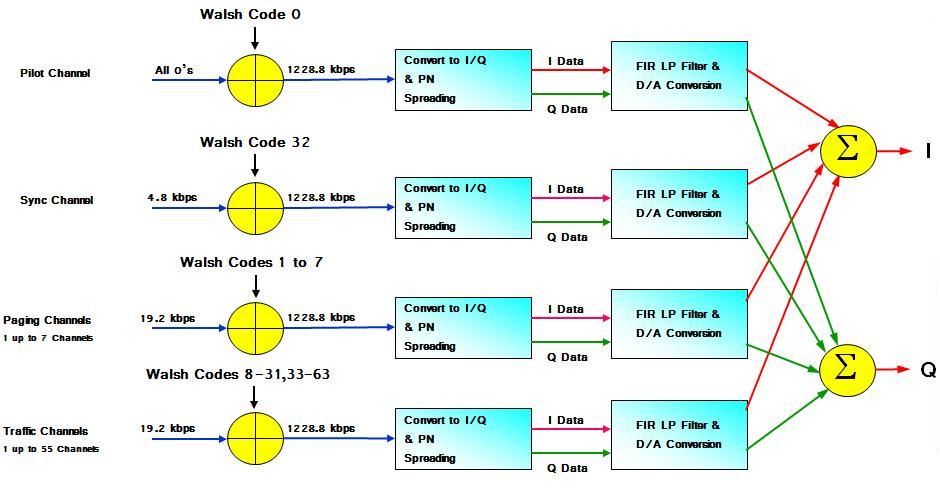The Base Station transmitter signal is, however, the composite of many channels (with a minimum of four). The Pilot channel is unmodulated (Walsh code 0); it consists of only the final spreading sequence (short sequences).
 The Pilot channel is used by all mobiles linked to a cell as a coherent phase reference and also provides a means for mobiles to identify cells from each other. The other three channels are the Sync channel, the Paging channel, and the Traffic channel which use the same data flow, but different data are sent on these channels.
The Pilot channel is used by all mobiles linked to a cell as a coherent phase reference and also provides a means for mobiles to identify cells from each other. The other three channels are the Sync channel, the Paging channel, and the Traffic channel which use the same data flow, but different data are sent on these channels.
The Sync channel transmits time of day information. This allows the mobile and the base to align clocks which form the basis of the codes that are needed by both to make a link. Specifically, one message sent by the Sync channel contains the state of the long code feedback shift registers 320 milli-seconds in the future. By reading this channel, CDMA mobile can load the data into its long code generator, and then start the generator at the proper time. Once this has been accomplished, the CDMA mobile has achieved full synchronization. The Sync channel always uses Walsh code channel 32.
The Paging channel is the digital control channel for the forward link. Its complement is the access channel which is the reverse link control channel. One base station can have multiple paging channels and access channels if needed. Up to seven Walsh code channels can be allocated for use as paging channels. The first paging channel is always assigned to Walsh code 1. When more paging channels are required, Walsh codes 2 through 7 are used.
The Traffic channel is equivalent to the analog voice channel. This is where the actual conversations take place. The remaining Walsh codes are assigned to traffic channels as required. At least 55 Walsh codes are available for use as traffic channels. The actual number that can be used is determined by the total interference levels experienced in any given cell. Nominal full loading would typically be around 30 traffic channels in use for equally loaded cells.
Once all of the various channels are Walsh modulated, they are converted into I/Q format, re-spread with the I and Q short sequences, low pass filtered to reduce occupied bandwidth, and converted into analog signals. The resulting analog I and Q signals from all the channels are summed together and then sent to the I/Q modulator for modulation onto an RF carrier.